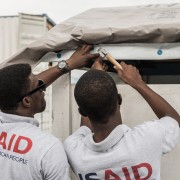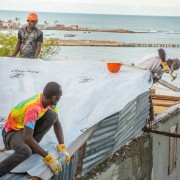Speeches Shim

To date, in response to Hurricane Matthew, the U.S. Government has committed $101.3 million in funding, including $42.6 million from USAID’s Office of Food for Peace (FFP), approximately $39 million from USAID’s Office of U.S. Foreign Disaster Assistance (OFDA), $11 million from the U.S. Department of Defense, and $8.7 million from the USAID Mission in Haiti. USAID’s assistance is carried out by more than 20 implementing partners and local organizations based in the hurricane-affected southwestern departments of Grande Anse, Nippes, and Sud.
WFP has reached nearly 925,000 people with food assistance since Hurricane Matthew struck Haiti in October 2016. Suspected cholera cases continue to decline, reaching lowest monthly caseload since August 2015. USAID programming in Haiti reaches more than 16,600 smallholder farmers with seeds and other agricultural inputs

Populations in Haiti, the Western Hemisphere’s poorest nation, are highly vulnerable to a variety of natural disasters, including hurricanes and earthquakes. To help communities respond more effectively to disasters, USAID’s Office of U.S. Foreign Disaster Assistance (USAID/OFDA) has developed a network of local surge capacity consultants. These USAID/OFDA-trained disaster specialists are familiar with the local context and can be activated to assist host government emergency response authorities, ground-truth disaster reports, conduct assessments, and help partners implement response activities more efficiently.

After Hurricane Matthew struck Haiti in October 2016, response actors estimated that as many as 35,000 families—approximately 175,000 people—in Grand’Anse and Sud departments whose homes were damaged or destroyed relocated to temporary shelters. USAID’s Office of U.S. Foreign Disaster Assistance (USAID/OFDA) responded by distributing emergency shelter supplies, including plastic sheeting and shelter repair kits, to help displaced households return home quickly.
The number of food-insecure people in Haiti’s hurricane-affected areas has decreased from approximately 1 million people as of late October to an estimated 400,000 people as of late December, according to the UN World Food Program (WFP)-led Emergency Food Security Assessment (EFSA) conducted from December 2–20. The EFSA also found a significant decline in the proportion of households adopting negative coping strategies due to food insecurity, with a 74 percent decrease in Sud Department, a 58 percent decrease in Grand’Anse Department, and a 54 percent decrease in Nippes Department.

Comment
Make a general inquiry or suggest an improvement.